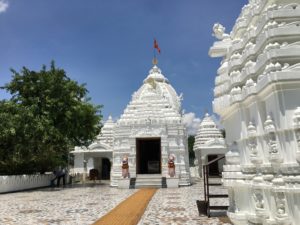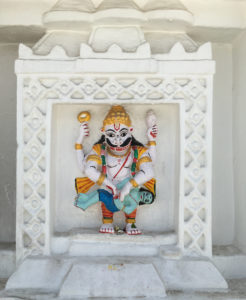By Shirin Mazdeyasna, 08/06/2016. The more I stay in New Delhi, the more I feel the similarity between here and my hometown Tehran. I love that I can identify like this and go back to my traits before moving to the US. I had missed risking every minute of precious life walking across the streets and highways with no red lights, having streams of cars pouring from all over. Being alive becomes much more valuable. My favorite time was close to Dilli Haat, a tourist shopping center that I met a classmate from Parsons, and the cars didn’t stop at the red light only because it was intended for people passing the street and not any cars crossing intersection. When we were about 7 people waiting to cross, the group started to shout at the cars and stop them, pointing their arms at the cars. I tagged along with them and successfully crossed the victorious achievement of the crowd. Power of people!
Walking places, using the bus and uberpool has offered me a lot of insight into the daily life of people here.

Uberpool passengers have offered me tips on restaurants, places to visit, and just normal things I wouldn’t notice. The other day I met two locals through uberpool and they pointed out to me the two Kanwariyas that were passing by the cars. That’s when I found out about Kanwar Yatra, which is an annual pilgrimage of devotees of Shiva. The devotees’ journal folds as walking from their town to Gangas river and bringing back water in their pots carried by Kavad (a bamboo pole) to their temple. The ritual came from when Ravana, a follower of Shiva, meditated and brought the water to sooth Shiva the negative suffering energy caused by the poison he inhaled. Such a powerful cause and journey! After knowing this, I could spot the tents and spots designated for Kanwariyas across town by volunteering organizations, providing them food and rest stations. The journey could be done alone, with another fellow, or even through different groups (I heard some even have a cart carrying music and deejays!).

Also, talking to locals lead me to knowing about the Amarnath temple, and how they described it was somehow different from what I later read on the Internet. They described the temple as a destination that devotees go to, and the journey to the temple is from harsh mountain roads that hundreds of people die each year either due to road accidents or falling off the cliffs since animals take up on the roads. When I read about it as one of the holiest shrines of Hinduism, I thought it’s very rad that due to its location, it is covered in snow most of the year and during a short period (a month or two) is in season for pilgrims. And the ice stalagmite created inside the cave is the purpose of worship and indeed where Shiva revealed the secret of life and eternity. Another amazing story about this temple is that between the Middle Ages and the 15th century, the cave was forgotten and under water/snow and was rediscovered by a shepherd.
In India, I feel a very strong sense of rituals in most things I observe around me. People live their religions passionately and devoutedly. I visited the Jagannath Temple in Hauz Khas and every single person’s behavior is with certainty to his practice. I feel to understand Hinduism or Jainism, you have to practice it through your daily life with strong devotion.



When I visited Akshadarham, from checking my bag to the cloakroom, to entering the corridors of the place, entering the holy temple, and indeed walking around it, all felt very ritualistic to me, as even me, a foreigner was doing a pilgrimage. The three exhibition at Akshadarham offered a great introduction to India’s 10000 years culture and philosophy and specifically learning about Swaminarayan, his journey through life, and what had been in him that has inspired thousands of people. The temple has been built by 11,000 artisans and volunteers during five years and the craftsmanship of the stone structure (no steel) is pretty wondrous. Akshadarham is the World’s Largest Comprehensive Hindu Temple and by followers it is known as “a temporal home of God on earth.” Unfortunately, no phones or cameras could be taken inside the site. No words can describe the manifestation of passionate belief.

The most powerful and mystic experience that I’ve had so far has been in the Gurudwara Bangla Sahib. When entering the temple, there was a place behind the kitchen that food and edibles were donated and for each day, thousands of people were freely fed. People passionately were donating their resources and time, working and helping (service to humanity). Everyone from all religions and casts are welcomed inside; all have to cover their head and bow to the Holy Book. Upon entering the temple, the spirit and the atmosphere was felt very sacred and reminded me of the notion of Darśana . Sikhism starting as a movement in 15th century to unite the conflicts between Muslims and Hindus and turning into its own religion combining the two is really awing. From Islam the monolithic God is deriving and from Hinduism the notions of the cycle of life and incarnation. I am AMAZED that such thing exists. Upon leaving the temple, a bite of sweetness (tasted like Halva to me) was being given to leave there with a sweet taste of God. They believe in living spirituality and leading an active life in society, no celibacy and becoming monks since their goal is service to humanity. Daytime is to work, night is to rest, and early morning before dawn is for prayer. Salvation can be achieved by earning an honest living in a normal life. And interestingly, they do not believe in idol-worshiping, rituals, or superstitious.The five symbols (K) that they follow are Kesha (unshorn hair, to respect nature of the body), Kangha (a comb), Kara (a steel bracelet), Kachha (a pair of shorts), and Kirpan (a sword). Seeing those who apply all are very easy since they are united in their uniform and this gives a real sense of brotherhood. When I was googling “Sikhism and haircut” (such irony!), I came upon a documentary on 6 different Sikh people (mostly young generations) who have cut their hair. Seeing that allowed me to get a better sense of their beliefs and traditions, as it was depicted how their families react to their decision.

What Akshadarham and The Sikh Temple has depicted to me is the existence of such strong and powerful spirituality in a leader or guru that years and centuries after, millions of people are still influenced and touched.
